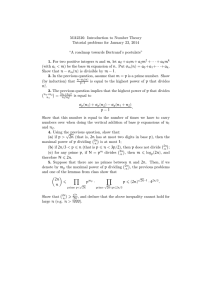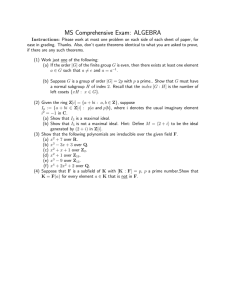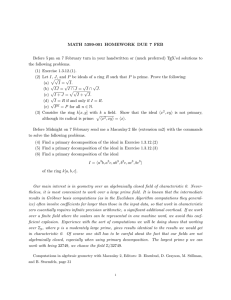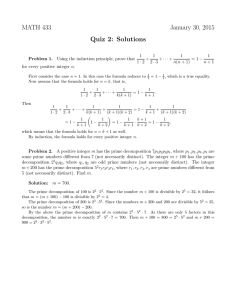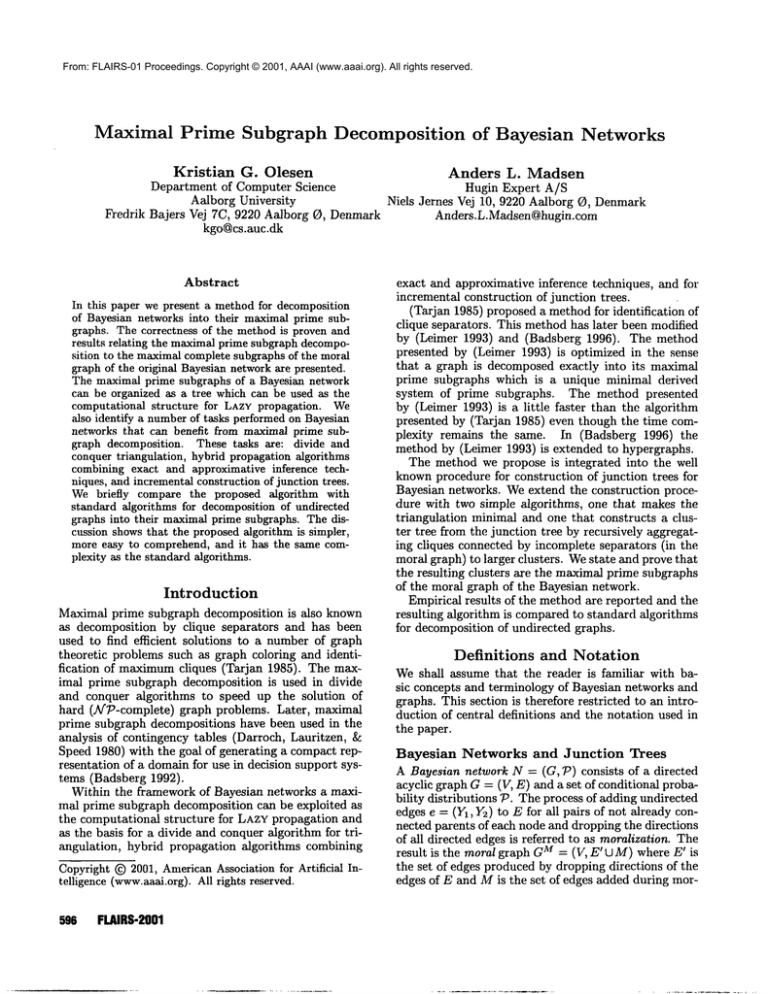
From: FLAIRS-01 Proceedings. Copyright © 2001, AAAI (www.aaai.org). All rights reserved.
Maximal
Prime
Subgraph
Decomposition
Kristian G. Olesen
of
Bayesian
Networks
Anders L. Madsen
Department of Computer Science
Hugin Expert A/S
Aalborg University
Niels Jernes Vej 10, 9220 Aalborg O, Denmark
Fredrik Bajers Vej 7C, 9220 Aalborg O, Denmark
Anders.L.Madsen@hugin.com
kgo@cs.auc.dk
Abstract
In this paper we present a methodfor decomposition
of Bayesian networks into their maximalprime subgraphs. The correctness of the methodis proven and
results relating the maximalprime subgraph decomposition to the maximalcomplete subgraphs of the moral
graph of the original Bayesian networkare presented.
The maximal prime subgraphs of a Bayesian network
can be organized as a tree which can be used as the
computational structure for LAZYpropagation. We
also identify a numberof tasks performedon Bayesian
networks that can benefit from maximal prime subgraph decomposition. These tasks are: divide and
conquer triangulation, hybrid propagation algorithms
combining exact and approximative inference techniques, and incremental construction of junction trees.
Webriefly compare the proposed algorithm with
standard algorithms for decomposition of undirected
graphs into their maximalprime subgraphs. The discussion showsthat the proposed algorithm is simpler,
more easy to comprehend, and it has the same complexity as the standard algorithms.
Introduction
Maximal prime subgraph decomposition is also known
as decomposition by clique separators and has been
used to find efficient solutions to a number of graph
theoretic problems such as graph coloring and identification of maximumcliques (Tarjan 1985). The maximal prime subgraph decomposition is used in divide
and conquer algorithms to speed up the solution of
hard (Af79-complete) graph problems. Later, maximal
prime subgraph decompositions have been used in the
analysis of contingency tables (Darroch, Lauritzen,
Speed 1980) with the goal of generating a compact representation of a domain for use in decision support systems (Badsberg 1992).
Within the framework of Bayesian networks a maximal prime subgraph decomposition can be exploited as
the computational structure for LAZYpropagation and
as the basis for a divide and conquer algorithm for triangulation, hybrid propagation algorithms combining
Copyright(~) 2001, AmericanAssociation for Artificial Intelligence (www.aaai.org).All rights reserved.
596
FLAIRS-2001
exact and approximative inference techniques, and for
incremental construction of junction trees.
(Tarjan 1985) proposed a methodfor identification
clique separators. This method has later been modified
by (Leimer 1993) and (Badsberg 1996). The method
presented by (Leimer 1993) is optimized in the sense
that a graph is decomposed exactly into its maximal
prime subgraphs which is a unique minimal derived
system of prime subgraphs. The method presented
by (Leimer 1993) is a little faster than the algorithm
presented by (Tarjan 1985) even though the time complexity remains the same. In (Badsberg 1996) the
method by (Leimer 1993) is extended to hypergraphs.
The method we propose is integrated into the well
knownprocedure for construction of junction trees for
Bayesian networks. Weextend the construction procedure with two simple algorithms, one that makes the
triangulation minimal and one that constructs a cluster tree from the junction tree by recursively aggregating cliques connected by incomplete separators (in the
moral graph) to larger clusters. Westate and prove that
the resulting clusters are the maximalprime subgraphs
of the moral graph of the Bayesian network.
Empirical results of the method are reported and the
resulting algorithm is compared to standard algorithms
for decomposition of undirected graphs.
Definitions and Notation
Weshall assume that the reader is familiar with basic concepts and terminology of Bayesian networks and
graphs. This section is therefore restricted to an introduction of central definitions and the notation used in
the paper.
Bayesian
Networks and Junction
Trees
A Bayesian network N = (G, 79) consists of a directed
acyclic graph G = (V, E) and a set of conditional probability distributions 79. The process of adding undirected
edges e = (Y1, Y2) to E for all pairs of not already connected parents of each node and dropping the directions
of all directed edges is referred to as moralization. The
result is the moral graph GM= (V, E~UM) where ~ i s
the set of edges produced by dropping directions of the
edges of E and Mis the set of edges added during mot-
alization. A moral graph GM is triangulated if every
cycle of length greater than 3 has a chord. The process of successively adding a set of edges T to a graph
G -- (V, E) such that G -- (V, E U T) is triangulated
is referred to as triangulation. The set of edges T is
called the triangulation and the edges of T are called
Jill-in edges. Thus, the triangulated graph of a directed
acyclic graph G = (V, E) is GT = (V, ~ UMU T)
A triangulation T is minimal, if removal of an edge
e E T results in an untriangulated graph. There exist mettlods for finding triangulations with a minimal
number of fill-in edges such as for example the LEX
Malgorithm (Rose, Tarjan, & Lueker 1976) (with time
complexity O(ne)). Heuristic methods for triangulation are in general not guaranteed to produce minimal
triangulations.
A non-minimal triangulation T can be
made minimal by applying a recursive thinning algorithm, that removes redundant fill-in edges added during triangulation.
Such an algorithm with time complexity O(ITI">) is described in (Kjmrulff 1993).
If the nodes V of a graph G can be partitioned into a
triple (W, S, V’) of non-empty sets where S is a complete separator of VI and V" in G such that every path
from a node Y~ E V~ to a node Y" E V" includes a node
in S, then G is decomposable(or reducible) otherwise G
is prime (or irreducible). Notice the terminology. In the
statistical
community a graph G is said to be decomposable if G and all its subgraphs can be decomposed
recursively until all subgraphs are complete. Werefer
to a recursively decomposable graph as a triangulated
graph.
A cluster tree representation T of a graph G = (V, E)
is a tree where the nodes of T axe subsets (clusters)
V and the union of all clusters equals V. The edge S
between two clusters C~ and C" of 7" is C~ I-1 C", the
separator of C~ and C". A junction tree (also referred
to as a Markovtree or a join tree) is a cluster tree with
the additional property that every cluster C on the path
between any two clusters C’ and C" includes C’ fq C".
A clique is a maximal complete subgraph. A clique
decomposition of a graph G with respect to a triangulation T consists of all cliques of GT. A clique decomposition can be represented as a junction tree 7"T where
T.
the clusters are tile cliques of G
A junction tree representation of a Bayesian network
N = (G, 79) can be constructed by the followin~ steps:
i) Moralize G to obtain GM, ii) Triangulate GM to obtain GT, iii) Organize the clique decomposition induced
by GT as a junction tree 7".
A maximal prime subgraph decomposition junction
tree representation 7"MPD of G is a junction tree for
an MPDwhere the nodes are the maximal prime subgraphs of G. A maximal prime subgraph decomposition
junction tree representation of a graph always exists.
In the following section we give an algorithm for the
construction of a maximal prime subgraph decomposition junction tree and a proof of the correctness of the
algorithm.
Example 1 [Asia]
The single most famous example of a Bayesian network
is the Asia network introduced by (Lauritzen & Spiegelhalter 1988). The graph of the Asia network is shown
in figure 1.
Figure 1: A Bayesian network for the Asia example.
The maximal prime subgraph decomposition
(moralised) Asia network is shownin figure
of the
Figure 2: The maximal prime subgraph decomposition
of the (moralised) Asia network.
[]
Maximal
Prime Subgraphs
A subgraph G(U) of a graph G = (V, E) is maximal
prime subgraph of G, if G(U) is prime and G(W) is decomposable for all W with U C W C V. The maximal
prime subgraph decomposition (MPD)of G is the set
induced maximal prime subgraphs of G.
Notice that a clique decomposition of a graph G with
respect to a triangulation T is a maximal prime subgraph decomposition of T.
G
Identifying
Maximal
Prime
Subgraphs
The method we propose for identification
of maximal
prime subgraphs of a Bayesian network N = (G, 79)
is based on a junction tree representation 7- of G. A
precondition of the method is that the triangulation T
from which 7" is constructed is minimal. This can be
obtained directly through an algorithm such as LEX
Mthat guarantees a minimal triangulation or, alterUNCERTAINTY 597
natively, recursive thinning can be applied to remove
redundant fill-in edges.
The main contributions of this paper is the algorithm
for constructing a maximal prime subgraph decomposition junction tree 7-MPDby aggregation of cliques connected by separators which are incomplete in the moral
graph and the proof of correctness of the algorithm
which follows below. A Bayesian network N = (G, P)
is decomposedinto its maximal prime subgraphs as follows. Let GM be the moral graph of G, let GT~" be the
graph corresponding to a minimal triangulation Train of
GM, and let 7-mi,~ be a junction tree corresponding to
the clique decomposition induced by GT~’". The maximal prime subgraphs of GM are formed by aggregating
adjacent cliques connected by a separator which is incomplete in GM. The algorithm is:
Algorithm 1 [Construct
MPD Junction
Tree]
Let N = (G, ~o) be a Bayesian network. Let 7"mi~ be
a junction tree representation of N constructed from a
minimal triangulation Train of GM. If Construct MPD
junction tree is invoked on Tmi,~, then:
1. Set 7" = Train2. Repeat
(a) Let S be a separator of I connecting C ’ and C".
(b) If GM(s) is incomplete, then aggregate C’ and
C" in T’.
Until no separator S of 7" such that GM(s) is incomplete exists.
3. Return TMPO = T’.
[]
In order to prove that TMVDis an MPDjunction tree
for GMthe following lemma is needed:
Lemma1. Each clique C of Train is a prime subgraph
M
of. G
Prvof. By contradiction. Let C be a clique in Train.
AssumeC is reducible in GM. Then there exist a complete maximal set S C C such that (C’,S,C") is a
decomposition of C for some C’, C" C C, see figure 3.
Next, we prove the main theorem of the paper.
Theorem 2
The clusters of TMPD constructed with algorithm 1 are
M.
exactly the maximal prime subgraphs of G
Proof. First we prove that every separator of 7-MPD is
a complete separator in GM. Let S be a separator of
TMPD and let C’ and C" denote the union of all clusters
on each side of S, see figure 4.
Figure 4: Ct and C" denote the union of all clusters on
each side of S.
The separator S is complete in GM by construction
and due to the junction tree property S -- C’ N C".
Hence, (C’ \ S, S, C" \ is a d ecomposition of GM.
Next, we prove that all clusters of "]-MPD are prime
subgraphs of GM. Let C be a cluster in TMPD which
is a clique in T,n~n. By lemma 1, C is a prime subgraph of GM. Now, let C be a cluster of TMPDconstructed by aggregation of cliques C1,..., Cn connected
by incomplete separators S1,...,Sn-1 in Train. Using
lemma1, a decomposition of Ci (for 1 < i < n) cannot
exists. Next, assume there exists a complete separator S = C~ N C" of two subsets C’, C" C C such that
C = C~ U C". There are three different ways in which
S can be related to C1,... ,Ca and Sx,... ,Sn-l:
1. S could be equal to Si for some 1 < i < n- 1, but
flSi : S = Si as S~ is incompletefor all 1 < i < n - 1.
2. S could be a subset of Ci for some 1 < i < n, but
/-~C~ : S C Ci as Ci is a prime subgraph for all
l<i<n.
3. Due to steps 1 and 2, it must be the case that 3X, Y E
S : xeCi, X¢C~,Y¢Ci,YeC~for some i and j
where 1 < i <nand 1 < j < n, but X ¢ adj(Y)
implies that S is incomplete.
c
Thus, the complete separator S cannot exists. Thus,
C must be a prime subgraph of M.
G
Finally, C is maximal as all separators of TMPD
are
complete separators of GM.
[]
Figure3:
A decomposition
of a cluster
C into
(c’,s,c").
But this means that the fill-in
edge between Y’ E
C’ and Y" E C" is redundant, contradicting the fact
that the triangulation is minimal. Thus C is a prime
subgraph of M.
G
[]
S98
FLAIRS-2001
Corollary 3. The maximal prime subgraph decomposition of GM is unique.
This result has also been proved by (Leimer 1993),
but here it follows directly from the proof of theorem 2
as all separators of 7-MPD are complete separators in
GM and no other complete separators exist. Although
of minor importance, we mention that 7~MPD is not necessarily unique. If two separators Si and Sj are identical
there exists at least three clusters sharing the same set
of nodes and they can be singly connected arbitrarily.
Wecan establish some further results relating the
clusters of "]-MPD to the cliques of M.
G
Proposition 4. The clusters
gregation of cliques of Train
of TMPDformed by agM.
not cliques in G
are
Proof. If C is a cluster in "-FMPD and not a clique in
Train then there exists a separator S C C that is not
complete in GM. Therefore C cannot be complete in
GM.
[]
Theorem 5
The clusters of
M
cliques
.
of G
7-AIPD
E
that are cliques of Train are also
Corollary 6. If C is a clique of Train and all separators
connected to C are complete in GM, then C is a clique
M
of G
Applications
This follows directly from theorem 5 as the cliques of
corollary 6 are exactly the clusters of theorem 5.
The condition in corollary 6 that all separators have
to be complete in GM is necessary, which follows from
the proof of the theorem. The proof can be found in
(Olesen & Madsen 1999).
The MPD Identification
Figure 5: A junction tree for the Bayesian network
shownin figure 1.
Algorithm
The purI)ose of the previous sections was to introduce
concepts, establish theoretical results including a proof
of the correctness of the algorithm, and describe an algorithm simplifying the description of the main algorithm of the paper:
Algorithm 2 [Construct
Maximal Prime Subgraph Decomposition Junction Tree]
Let N = (G,7 9) bc a Bayesian network. If Construct
ma:l:imal pr’irae subgraphdecompositionjunction tree is
invoked on G, then:
1. Moralize G to o/)tain G/tt.
2. Triangulate GMT.
to obtain G
3. Thin out redundant fill-in edges (only performed if
T’.
necessary) to obtain G
4. ()rganize the clique decomposition induced by GT’ as
a junction tree T.
5. Construct the MPDjunction tree 7"MPD (algorithm 1).
6. Return 7~1pn.
[]
Using the above algorithms the organization of the
junction tree T also determines the organization of the
maximal prime subgraph decomposition junction tree
7)41,r). It is, however, possible to organize TMPD
independently of tim structure of T.
Example 2 [Asia]
A junction tree for Asia constructed with moral links
(T, L) and (E, B), and fill-in edge (B, L) is shown
figure 5. Cliques BLS ~md BEL are aggregated to
form the MPDjunction tree since the separator BL is
M.
incomplete in G
[]
In this section we discuss some tasks commonlyperformed on Bayesian networks that might benefit from
maximal prime subgraph decomposition.
Lazy Propagation
in MPD Junction
Trees
In (Madsen ~z Jensen 1999) the LAZYpropagation architecture was described as a junction tree message
passing algorithm. Any computational tree structure
maintaining the independence relations of the corresponding Bayesian network can be used to control the
flow of messages in the LAZYpropagation architecture.
An MPDjunction tree could, for instance, be used instead of a junction tree.
Message passing and absorption of evidence in an
MPDjunction tree proceeds in exactly the same way as
in junction trees. Thus, changing the underlying structure of the LAZYpropagation architecture from junction trees to MPDjunction trees does not impose any
major adjustments to the inference algorithm. LAZY
propagation often produces smaller potentials when
performed in MPDjunction trees than when performed
in general junction trees. It can be demonstrated that,
an MPDjunction tree does not eliminate the possibility
of introducing unuecessary fill-in edges during message
passing with LAZYpropagation. The number of unnecessary fill-in edges introduced will, however,be reduced.
Triangulation
by Divide and Conquer
In order to obtain a computationally efficient triangulation of the graph G of a Bayesian network we can exploit
the cluster tree representation "]-AIPD of the maximal
prime subgraph decomposition of G. By proposition 4
and theorem 5 we can identify a partial triangulation of
GM. Although a complete triangulation was identified
during the construction of T~4pD, this need not be a
good one. Hence we can re-triangulate
the clusters of
THIRD that are uot triangulated
already and obtain a
new total triangulation. The non-triangulated clusters
of GM are smaller than the original graph and they can
be triangulated indepeudently. Therefore, the original
triangulation problem is split into a number of independent subproblems of smaller sizes. It follows that a
divide and conquer strategy for triangulation consists
UNCERTAINTY 599
of a maximal prime subgraph decomposition of GM followed by a triangulation of all clusters of TMPD. Different methodsfor triangulation can be used for different
clusters, or the clusters can be triangulated in parallel.
It is clear that the efficiency of the approach increases
¯ with a decreasing size of the maximalprime subgraphs.
Hybrid Propagation
Even though efficient triangulations can be obtained
by the divide and conquer approach just described, the
cliques of the junction tree maybe too large for inference by exact methods. When Bayesian networks becomeso large that probabilistic inference cannot be performed on the available hardware approximative methods can be applied. In such cases inference can be performed by stochastic simulation or through other approximation methods. Such methods are also relevant
if the Bayesian network includes arbitrarily distributed
continuous variables for which exact methods do not
exist. Approximative and stochastic simulation methods are most often applied to the entire computational
structure. In (Dawid, Kj~erulff, & Lauritzen 1995)
methodology for performing approximate computations
in large junction trees where some cliques are handled
exactly and others by approximation or stochastic simulation is described. The emphasis of (Dawid, Kjaerulff,
& Lanritzen 1995) is on the methodology for combining the inference algorithms whereas the construction
of the computational structure for mixed propagations
is not treated. MPDjunction trees can be used as the
basis for construction of computational structures for
hybrid propagation.
Incremental
Compilation
During the model design and construction phases, the
structure of the Bayesian network will often be changed
frequently. The model is changed both to improve the
conceptual representation
of the domain being modeled, but model constructs are also changed to improve
the efficiency of the model. Changing the structure of
the Bayesian network has implications to the structure
of corresponding junction trees and the efficiency of a
Bayesian network is almost always measured as the efficiency of the corresponding junction tree. Therefore, it
is important to consider how structural changes to the
Bayesian network effects the structure of corresponding junction trees. Once a junction tree representation
of a Bayesian network has been generated incremental changes made to the Bayesian network should produce incremental changes to the initial junction tree
representation. Methods for dynamically adjusting the
computational structure has been developed, see for instance (Draper 1995) and (Darwiche 1998).
(Draper 1995) argues that if the Bayesian network
large, then it will often be considerably less expensive
to modify an existing junction tree than to perform a
new compilation and that incremental modification of
a junction tree will often produce more stable results.
This is especially important if the designer is trying
600
FLAIRS-2001
to optimize the junction tree representation. With the
MPDjunction tree as an intermediate representation it
is possible to modify the junction tree dynamically as
changes in the Bayesian network are introduced. These
changes will typically influence only one or a few clusters in the MPDjunction tree and only the cliques of
the junction tree constructed from the triangulation of
these clusters have to be modified, while the rest of the
junction tree remains intact. Methods for incremental
compilation based on this idea is under current investigation.
Sample
Empirical
Results
The utilization of MPDjunction trees to some degree
depends on the size of the maximal prime subgraphs
of the decomposition. A series of empirical evaluations
investigating the sizes of maximal prime subgraphs of
a number of large real-world Bayesian networks have
been performed.
The Bayesian networks are decomposed into maximal prime subgraphs. For each size of the maximal
prime subgraphs, the accumulated number of variables
in subgraphs of this size is computed. These numbers
are related to the size of the maximalprime subgraphs
as illustrated in figure 6.
Munin
A cumulated
number of variables
--
1000
.~ soo
600
400
200
5
i0
15
20
25
30
35
Maximum prime subgraph size
40
Figure 6: The accumulated number of variables in maximal prime subgraphs of equal size as a function of the size of the maximal prime subgraphs for the Munin network.
A typical result is that a large fraction of the variables lies in small maximalprime subgraphs and a single subgraph is quite large. In some networks up to
half of the variables are contained in a single subgraph.
Figure 6 shows the results for a fraction of the Munin
network (Andreassen, Falck, & Olesen 1992) containing
1066 nodes. This network contains 12 maximal prime
subgraphs with 12 or more variables in each. Thus e.g.
an exhaustive search for an optimal triangulation is still
without reach, but the resources can be directed towards the crucial parts of the network.
Comparison
with Existing
Methods
In this section we briefly compare the proposed algorithm for maximal prime subgraph decomposition (algorithm 2) to existing algorithms proposed by (Tar jan
1985) and (Leimer 1993). Space limitations prohibits
an in depth analysis, instead we refer the interested
reader to (Olesen & Madsen 1999).
The time. complexity of the algorithms for finding maximal prime subgraph decompositions presented
by (Tarjan 1985) and (Leimer 1993) O(ne) where n
is the number of nodes and e is the number of edges of
the decomposed graph.
The algorithm proposed by (Tarjan 1985) finds
prime decomposition of the undirected graph G, but
the prime subgraphs of the decomposition are not necessarily the maximal prime subgraphs nor does the algorithm produce a unique decomposition.
The algorithm proposed by (Leimer 1993) is a modication of the one presented by (Tarjan 1985) that determines the unique maximal prime subgraph decomposition of G. The algorithm iterates through all separators
in a fixed order resulting in a skewed binary decomposition tree.
The method for maximal prime subgraph decomposition we propose, is based on arranging the cliques of
GT in a arbitrary junction tree and then inspecting
the separators of the junction tree. Hence, the order
in which the separators are inspected is unimportant.
This enables parallel instead of sequential inspection of
separators.
The methods proposed by (Tarjan 1985) and (Leimer
1993) are both based on decomposition of undirected
graphs. The method we propose is based on decomposition of the moral graph of a directed acyclic graph.
For instance, the graph of a Bayesian network. For
the sake of comparison with the existing methods it is
therefore fair to disregard the moralization step of the
method we propose. The time complexity of the three
methods is O(ne), see (Olesen & Madsen 1999).
Conclusion
In this paper wc have presented a method for maximal prime subgraph decomposition of Bayesian network. The method is similar to the method of (Tarjan
1985) as modified by (Leimer 1993). The advantage
the proposed methodis that it integrates nicely into the
construction of junction trees for Bayesian networks.
Furthermore, the requirement that the cliques of the
triangulated graph are arranged in a specific unique order is relaxed and the separators of the triangulated
graph can be inspected in any order.
The maximal prime subgraphs are organized into an
MPDjunction tree. The MPDjunction tree can serve
as the computational structure for LAZYpropagation
and for hybrid propagation schemes. Furthermore, by
maintaining the MPDjunction tree structure as an intermediate representation between the Bayesian network and a corresponding junction tree methods for
divide and conquer triangulation, and incremental construction of junction trees can be employedefficiently.
The results of empirical experiments indicate that a
maximal prime subgraph decomposition typically produces a few relative large maximalprime subgraphs and
a number of small maximal prime subgraphs. Further
research is needed in order to draw precise conclusions
on the importance of exploiting maximal prime subgraph decompositions.
References
Andreassen, S.; Falck, B.; and Olesen, K. G. 1992. Diagnostic function of the microhumanprototype of the
expert system MUNIN.Electroencephalography
and
Clinical Neurophysiology 85:143 -157.
Badsberg, J. H. 1992. Model search in contingency
table by CoCo. In Dodge, Y., and Whittaker, J., eds.:
Computational Statistics,
COMPS
TA T, 251-256.
Badsberg, J. H. 1996. Decomposition of graphs and
hypergraphs with identification
of conformal hypergraphs. Technical Report II-96-2032, Department of
Computer Science, Aalborg University, Denmark.
Darroch, J.; Lauritzen, S.; and Speed, T. 1980.
Markov fields and log-linear interaction models for
contingency tables. Annals of S~atistics 8(3):522-539.
Darwiche, A. 1998. Dynamicjointrees. In Proceedings
of the l~th Conference on UAI, 97-104.
Dawid, A.; Kj~erulff, U.; and Lauritzen, S. 1995. Hybrid propagation in junction trees. In Advances in
Intelligent Computing, volume 945 of Lecture Notes in
Computer Science. B. Bouchon-Meunier et al. 87-97.
Draper, D. 1995. Clustering
Without (Thinking
About) Triangulation. In Prxvceedings of the 11th Conference on UAL125-133.
Kjmrulff, U. 1993. Aspects o[ efficiency improvement
in Bayesian networks. Ph.D. Dissertation,
Department of Computer Science, Aalborg University, Denmark.
Lauritzen, S. L., and Spiegelhalter, D. J. 1988. Local computations with probabilities on graphical structures and their applicatior~ to expert systems. Journal
of the Royal Statistical Society, B. 5(}(2):157-224.
Leimer, H.-G. 1993. Optimal dccomposition by clique
separators. Discrete Mathematics 113:99-123.
Madsen, A. L., and Jensen, F. V. 1999. Lazy propagation: A junction tree inference algorithm based on lazy
evaluation. Artificial Intelligence 113(1-2):203---245.
Olesen, K. G., and Madsen, A. L. 1999. Maximal
prime subgraph decomposition of Bayesim~ nctworks.
Technical report, Aalborg University, Denmark.
Rose, D.; Tat:inn, R..~ and Lueker, G. 1976. Algorithmic aspects of vertex elimination on graphs. Siam
Journal of Computing 5(2):266-283.
Tarjan, R. E. 1985. Decomposition by clique separators. Discrete Mathematics 55:221--232.
UNCERTAINTY 601

